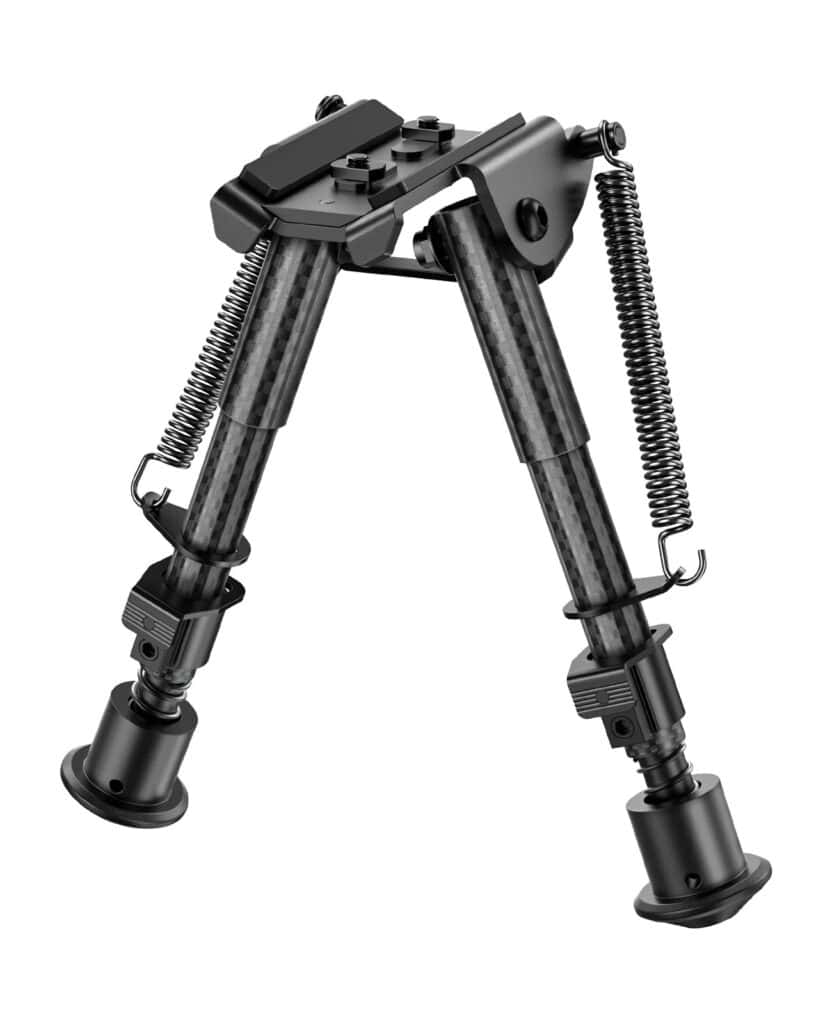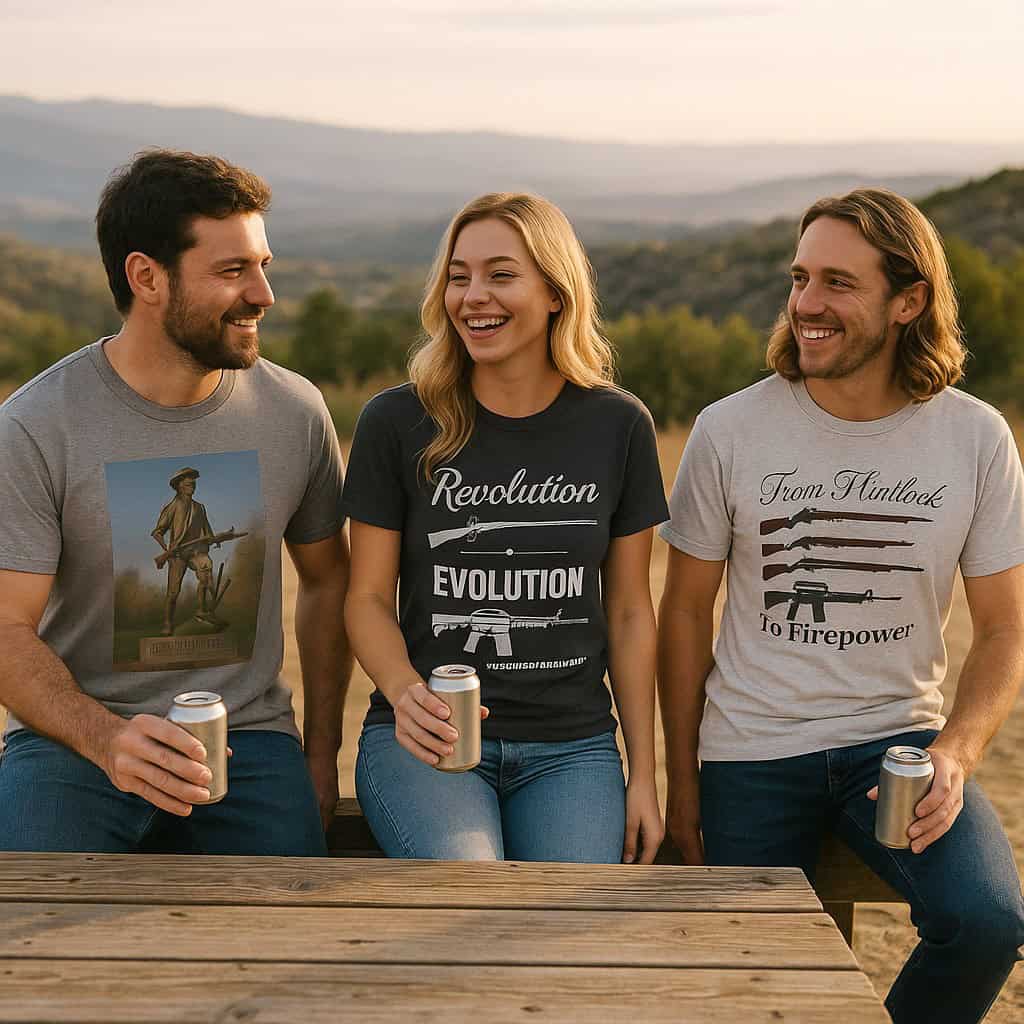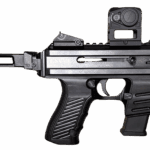
If your rifle spends any real time on a bench, prone mat, or prairie dog town, a bipod isn’t optional—it’s a core stability system. Over the last few years I’ve run everything from classic spring-leg steel to boutique, multi-articulated aluminum rigs with quick-detach mounts and exotic feet. The CVLIFE carbon-fiber series sits in an interesting lane: budget pricing with materials and features that look, on paper, like they belong a tier or two up. This review takes a hard, factual look at what you actually get, how it stacks up against heavy hitters like Harris, Atlas (B&T Accu-Shot), and Magpul, and where CVLIFE punches above its weight versus where the bigger names still earn their keep.
What the CVLIFE Carbon-Fiber Bipods Actually Are
CVLIFE offers carbon-fiber–leg bipods in common height ranges (notably 6–9 inches) with options for Picatinny and M-LOK mounting. The legs use real carbon-fiber tubes with metal hardware at the head and hinges. CVLIFE lists the Picatinny model at about 8.8 ounces with 6–9 inch adjustment via notches/leg buttons and spring-assisted deployment; it ships with a Picatinny adapter when needed.
There’s also an M-LOK variant that bolts directly to the M-LOK rail (no adapter required). CVLIFE advertises this model as 0.54 lb (about 8.6 oz) and again calls out carbon fiber plus lightweight aluminum hardware.
These adapters are also available separately.
Notably absent from their feature lists are claims about a built-in pan (left/right sweep) or a true cant/tilt lock knob integrated into the head—features you’ll see advertised (boldly) by the bigger names. In other words, the CVLIFE carbon-fiber units are straightforward: light, rigid legs; spring return; notch adjustments; and common mounting options. If you need independent pan/tilt control with a preload knob, keep reading into the competitor comparisons.
Street price & availability: CVLIFE’s carbon-fiber 6–9″ class commonly lists between about $35–$55, depending on finish/color bundle and retailer; the company store and big-box marketplaces show those ranges. For example, an in-line CVLIFE page for a red-accent 6–9″ Picatinny version shows a typical under-$50 sale price, which matches what I’ve seen broadly.

Specs & Features at a Glance
Below is a concise, apples-to-apples snapshot of comparable “bench/prone height” bipods, including the CVLIFE carbon-fiber class and well-known competitors.
- CVLIFE Carbon-Fiber (Picatinny, 6–9″)
Height: 6–9″; Weight: ~8.8 oz; Material: carbon-fiber legs with metal head/hinges; Mount: Picatinny (adapter often included); Features: spring return, buttoned leg notches. Pan/Tilt: not advertised. - CVLIFE Carbon-Fiber (M-LOK, 6–9″)
Height: 6–9″; Weight: ~0.54 lb (~8.6 oz); Material: carbon fiber + aluminum; Mount: direct M-LOK (no adapter); Features: similar leg adjustments. Pan/Tilt: not advertised. - Harris S-BRM / S-BRMS (6–9″ swivel)
Height: 6–9″; Weight: commonly specified around 14 oz (some retailer variants list ~11–12 oz depending on mount format); tilt (“swivel”) is standard; notched legs; spring deployment; sling-stud base (with available adapters for rails). - Atlas BT10 V8
Height range about 4.8–9.1″; Weight: ~11.0 oz; 5 leg positions (0/45/90/135/180°); preloaded pan 30° and preloaded cant 30°; aluminum/stainless; various clamps (2-screw, or QD LW17). - Magpul Bipod (M-LOK)
Height: 6.8–10.3″ (seven half-inch detents); Weight: just over 11 oz; tilt 50° total and pan 40° total with a tool-less locking knob; can lock out pan while maintaining tilt; polymer/aluminum hybrid build.
Immediate takeaway: The CVLIFE Carbon-Fiber bipod's headline win is weight—coming in distinctly lighter than Harris or Magpul and even under Atlas, while staying in the familiar 6–9″ “standard” prone/bench window. You give up sophisticated pan/cant controls the premium models tout, but you keep core stability and a notably low mass, which matters on a hunting rifle or a field carbine where ounces are enemies.
Build Quality, Fit, and Field Use
Materials & rigidity. The carbon-fiber tubes on the CVLIFE legs are the real draw: they’re stiff for the weight and resist the kind of oscillation you can induce in thin-wall aluminum legs when you preload hard into a bipod on dirt or short grass. That rigidity is consistent with carbon-fiber’s modulus benefits and is corroborated by CVLIFE’s own positioning (“higher strength than aluminum at lower weight”).
Head/hinge hardware. The head assembly is utilitarian metal with coil springs for leg snap-out and push-buttons for notch stops. Tolerances are serviceable; you’ll feel a little play at the hinge compared to Atlas’s tightly machined detents and plunger system, and it lacks the buttery tension knob for tilt/pan found on Magpul’s unit. If you’re used to a Harris swivel model, you’ll miss the simple “tilt to level” function when you’re on uneven ground because the CVLIFE, as advertised, doesn’t offer a specific pan/tilt mechanism built in.
Mounting. Two common flavors cover most rifles out of the box. The Picatinny version of the CVlife Carbon-Fiber bipid mounts easily to common rail sections; if your rifle only has a sling-stud, you’ll rely on the included adapter (where provided) or add a small rail section. The M-LOK direct-attach is slick for modern handguards—no extra adapter height, cleaner install, and fewer parts to work loose.
On the bench vs. in the field. Prone behind a light sporter or AR, CVLIFE’s carbon tubes damp well, and the low weight means your muzzle balance stays lively for positional transitions. On a concrete bench, stability is absolutely adequate for zeroing and load workups. Where you feel the price delta is when you start preloading forward while also needing to correct for cant on uneven terrain—a Harris S-BRM or Magpul’s tilt knob let you stay locked in the gun while you level the reticle. Atlas takes this control even further with preloaded pan/cant and multiple leg positions for tricky obstacles.
Durability notes. Budget bipods live or die by screws and pins staying put. There are scattered user reports over the years of screws backing out on value-tier bipods (including legacy CVLIFE models). If you run a lot of recoil cycles or miles of rutted two-track, add blue thread-locker to the hinge and clamp hardware after your initial fitting and re-check torque after your first range day. This matches anecdotal community feedback I’ve seen (“screws walking”) and is a generic best practice for any budget head casting.
How It Stacks Up Against the Classics and the Premiums
CVLIFE vs. Harris (S-BRM / S-BRMS)
- Weight: CVLIFE wins by a lot (~8.6–8.8 oz vs. ~14 oz typical for the classic S-BRM swivel model).
- Leveling/Cant: Harris swivels (tilts) by design and stays an ergonomic champ for quick level corrections in natural terrain. CVLIFE’s product pages don’t advertise tilt/pan; advantage Harris for field unevenness.
- Mounting: Harris is traditional sling-stud first; you’ll add an adapter for rails. CVLIFE sells Pic and direct M-LOK versions, making it simpler on modern carbines.
- Price: CVLIFE is dramatically cheaper. Harris commands roughly $110–$125 and up in this class.
Verdict: If you need tilt for hunting slopes or practical field matches and accept more weight, Harris remains superb. If you want the lightest 6–9″ option that’s rail-friendly out of the box, CVLIFE is compelling.
CVLIFE vs. Atlas BT10 V8
- Precision mechanics: Atlas is in another universe on machining tolerance and leg position articulation (0°, 45°, 90°, 135°, 180°). You also get preloaded pan and cant of 30° each—a huge usability step for barricades and broken ground.
- Weight: Atlas is light for its feature set at ~11.0 oz, but the CVLIFE Carbon-Fiber bipod is still a couple ounces lighter.
- Cost: Atlas is premium; by the time you add the LW17 QD lever, you’ll be several multiples of the CVLIFE’s price.
Verdict: If you want match-grade head control and multi-angle legs, Atlas is the obvious pick. If you prioritize weight and price while keeping baseline stability for prone/bench, CVLIFE’s value is undeniable.
CVLIFE vs. Magpul Bipod
- Controls: Magpul offers tool-less pan/tilt (50° tilt, 40° pan) with the ability to lock out pan independently—clever and very usable.
- Weight: “Just over 11 oz,” again very respectable; CVLIFE Carbon-Fiber remains lighter by ~2–3 oz depending on variant.
- Heights: Magpul’s 6.8–10.3″ spans a bit taller than a “pure” 6–9. If you shoot over scrub or in snow, that extra inch helps.
Verdict: The Magpul is a feature-rich do-it-all with excellent control; CVLIFE Carbon-Fiber bipod is the lightweight minimalist. Choose based on whether you need pan/tilt or absolute ounce-counting.
Real-World Pros
- Outstanding weight-to-stability ratio. Coming in around 8.6–8.8 oz in the standard height class is impressive and noticeable on the muzzle. It’s lighter than many aluminum competitors without feeling flimsy thanks to the carbon tubes.
- Modern mounting friendliness. The direct-attach M-LOK model simplifies installation, reduces stack-up height, and cuts parts count. The Picatinny model remains universal for traditional rails.
- Straightforward operation. Spring return, push-button notches, and a compact fold keep the learning curve short and the folded footprint tidy—ideal for a general-purpose AR or a light hunting rifle.
- Price-to-performance. In a world where $100–$300 bipods are normal, getting carbon-fiber legs, sub-9-oz weight, and common mounts for well under $100 is remarkable.
Real-World Cons (and How to Mitigate)
- No advertised pan/tilt. If your use case involves uneven ground, awkward barricades, or frequent reticle leveling, you’ll feel the lack of a tilt knob or pan sweep. Mitigation: pair the bipod with a small leveling wedge/bag under the buttstock or run an adjustable mount plate. For dedicated field matches, consider stepping up to Harris/Magpul/Atlas.
- Budget-tier fasteners. Community experiences have included occasional screws backing out on value bipods. A dab of blue Loctite on installation and periodic torque checks go a long way.
- Feature ceiling. You won’t get Atlas’s five leg angles, preloadable pan/cant, or a QD lever head at this price. If those are must-haves, you already know where to look.
Who the CVLIFE Carbon-Fiber Bipods Are Perfect For
- Hunters and field rifle owners who value low weight but still want a rigid, reliable 6–9″ platform for prone shots and quick benchtop zero checks. The carbon tubes give you confidence without front-heavy feel.
- General-purpose AR shooters who mostly shoot from the bench or prone, occasionally off a pack, and don’t need to dial pan/tilt for every stage. The M-LOK version in particular is a clean install on modern handguards.
- Budget-conscious enthusiasts who want to spend on optics, ammo, or a trigger, yet still appreciate the tangible upgrade to stability that a carbon-leg bipod brings over the very cheapest stamped or pot-metal options.
Who Should Step Up to a Premium Model
- If you regularly shoot practical/NRL-type stages, barricades, rooftops, and highly uneven terrain, you will benefit from tilt/pan control and multi-angle legs. The Harris S-BRM gives you simple, proven tilt in the same 6–9″ envelope. The Magpul bipod adds broader tilt and pan with tool-less locking. The Atlas BT10 layers on refined machining, multiple leg angles, and preloadable pan/cant that serious positional shooters prize.
- If you need repeated on/off with return-to-zero and bombproof clamping, Atlas’s LW17 QD option is the gold standard in this size class, albeit at a premium price and weight penalty relative to CVLIFE.
Mounting, Setup, and Maintenance Best Practices
- Choose the right base. If your rifle already has M-LOK, the CVLIFE direct-attach M-LOK is the neatest solution. If you’re running a Pic rail fore-end, the Picatinny model is plug-and-play. Sling-stud only? Add a stub rail or use the included adapter (when provided).
- Torque and thread-locker. Clean the screws with alcohol, apply blue (medium) thread-locker, and torque to spec. Re-check after your first live-fire session. That advice applies to budget and premium bipods alike, but it’s doubly useful here given community reports on inexpensive units.
- Leg length etiquette. On a flat bench, start around mid-notch and fine-tune; in the field, keep the buttstock supported (small rear bag or pack) and run the shortest stable setting to minimize sight wobble. If you’re on a side hill and you must level, a wedge under the butt is the practical workaround on CVLIFE since the head lacks tilt locks.
- Feet and surfaces. The CVLIFE Carbon-Fiber bipod ships with standard rubber-style feet suited to benches and dirt. If you need spikes or claws, understand that one big price difference in premium bipods is their accessory ecosystem—Atlas, for example, has a deep catalog. That’s less a knock on CVLIFE than a reality of its price point.
Bottom Line: A Legitimate Lightweight Workhorse, Not Just a “Budget If You Must”
You should buy gear for the way you actually shoot. If what you need most is a light, rigid, simple, 6–9″ prone/bench bipod that bolts cleanly to an M-LOK handguard or Picatinny rail, the CVLIFE Carbon-Fiber series delivers exactly that—and it does so at remarkably low mass and remarkably low cost. The penalty for saving money and ounces is giving up tilt/pan controls and the ultra-precise feel of a Harris/Magpul/Atlas head. For many shooters—especially hunters and general-purpose AR owners—that trade is not only acceptable, it’s smart.
In direct comparisons:
- It out-lightweights Harris and Magpul by a meaningful margin, and even undercuts Atlas on the scale.
- It’s far less expensive than all three while preserving the core function that matters most: a stable front support that deploys quickly and stays put.
- It’s simpler—which is both its strength (less to fiddle with, less weight) and its limitation (no tilt/pan knob, fewer leg positions).
If your mission profile leans toward precision positional work on varied terrain, buy once/cry once and step to Harris, Magpul, or Atlas for their tilt/pan mechanisms and expanded adjustability. If you want to shed ounces, spend less, and get 90% of what most shooters truly use day-to-day, the CVLIFE carbon-fiber bipods are more than “good for the price.” They’re good—period—and an easy recommendation as a lightweight, reliable front support that won’t make your rifle feel like it’s wearing a boat anchor.
Quick Decision Table: Which Bipod is Right for You?
| Rifle Type / Use Case | Recommended Bipod | Why It Fits | Trade-Offs |
|---|---|---|---|
| Lightweight Hunting Rifle (sporter bolt gun, mountain rifle) | CVLIFE Carbon-Fiber (M-LOK or Picatinny) | Ultralight (~8.6–8.8 oz), carbon-fiber rigidity, no excess bulk. Ideal for carrying long miles and dropping prone for a steady shot. | No tilt function—on uneven terrain you’ll need to adjust with your rear support. |
| General-Purpose AR (range work, varminting, casual prone shooting) | CVLIFE Carbon-Fiber M-LOK | Direct M-LOK attach keeps profile low, simple leg adjustments, affordable enough for a “set it and forget it” accessory. | Missing pan/tilt compared to premium AR-focused bipods. |
| Traditional Hunting Rifle with Sling Stud Only | Harris S-BRM / S-BRMS | Classic design, built-in swivel (tilt), robust, proven in the field for decades. | Heavier (~14 oz), needs an adapter for rail systems, higher price. |
| Precision Rifle / Competition (NRL, PRS, barricade work) | Atlas BT10 V8 (with LW17 QD if needed) | Five leg positions, preloadable pan and cant (30° each), precision machining, QD option for quick swap between rifles. | Cost is 4–6x CVLIFE, slightly heavier (11–12.7 oz). |
| Do-It-All Carbine (range to practical shooting, mixed positions) | Magpul Bipod (M-LOK) | Good balance of weight (~11 oz), wide tilt (50°) and pan (40°), tool-less knob to lock movement, accessible price point. | Heavier than CVLIFE; polymer/aluminum hybrid may not appeal to everyone. |
Final Word
The CVLIFE carbon-fiber series doesn’t pretend to be an Atlas or Harris—but it doesn’t have to. For most shooters who spend their time on the bench, on the range, or in open country where light weight, simplicity, and stability are the only real requirements, these bipods are an excellent choice. They’re not just “good for the money.” They’re flat-out good, and the decision table above makes it easy to see where they shine versus where stepping up to a premium model makes sense. Their aluminum models are equally as good at just a fraction more weight.
The CVlife Carbon-Fiber bipod for swivel mounts can be purchased direct here or from Amazon here.
The CVlife Carbon-Fiber bipod for MagLok mounting can be purchased here or from Amazon here.
The pic-rail version of the CVlife Carbon-Fiber bipod can be purchased here or from Amazon here.
If you know of any forums or sites that should be referenced on this listing, please let us know here.




